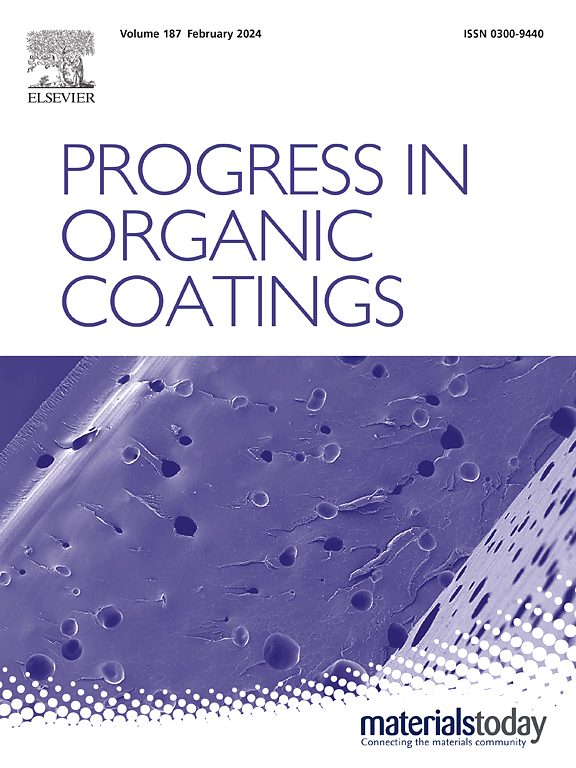Green superhydrophobic surface engineering of PET fabric for advanced water-solvent separation
IF 6.5
2区 材料科学
Q1 CHEMISTRY, APPLIED
引用次数: 0
Abstract
This paper presents the preparation of the PET membrane for effective organic solvent separation achieved through an advanced superhydrophobic surface engineering of PET fabric utilizing biomimicry and a green chemistry approach. The superhydrophobicity of the PET surface was reached through a hierarchical nanocomposite coating that involved the integration of biomimetic polydopamine (PDA) coating, green-synthesized zinc oxide (ZnO) nanoparticles (NPs), and non-fluorinated quaternary ammonium cation silane (Si-QAC) coverage. The morphology and surface chemical composition of the resultant Si-QAC/ZnO/PDA@PET membrane were characterized by SEM, EDS, FT-IR, XRD, and AFM analysis. The surface topography and water contact angle were also correlated with surface roughness and its superhydrophobicity. The resulting Si-QAC/ZnO/PDA@PET membrane exhibited promising superhydrophobic properties, characterized by a water contact angle ranging from 150° to 160° and a roll-off angle between 5° and 2° as well as stability against severe conditions, including acidic and alkaline exposure, mechanical abrasion, and UV radiations. Moreover, the Si-QAC/ZnO/PDA@PET membrane exhibited bacterial repulsive properties against E. coli and Staphylococcus sp. The separation efficiency of various aliphatic and aromatic organic solvents (n-hexane, toluene, chloroform, and petroleum ether) from water higher than 90 % was also observed, making the membrane a potential candidate for different industrial applications, particularly for the separation of organic solvents from water.
用于先进水溶剂分离的 PET 织物的绿色超疏水表面工程
本文介绍了利用仿生学和绿色化学方法,通过对 PET 织物进行先进的超疏水表面工程,制备出可有效分离有机溶剂的 PET 膜。PET 表面的超疏水性是通过分层纳米复合涂层实现的,其中包括仿生物聚多巴胺(PDA)涂层、绿色合成的氧化锌(ZnO)纳米颗粒(NPs)和非氟化季铵阳离子硅烷(Si-QAC)覆盖层。通过 SEM、EDS、傅立叶变换红外光谱、XRD 和原子力显微镜分析,对 Si-QAC/ZnO/PDA@PET 膜的形貌和表面化学成分进行了表征。表面形貌和水接触角也与表面粗糙度及其超疏水性相关。所制备的 Si-QAC/ZnO/PDA@PET 膜具有良好的超疏水性能,其水接触角在 150° 至 160° 之间,滚落角在 5° 至 2° 之间,并且在酸性和碱性暴露、机械磨损和紫外线辐射等恶劣条件下具有稳定性。此外,Si-QAC/ZnO/PDA@PET 膜对大肠杆菌和葡萄球菌也有抑菌作用。从水中分离各种脂肪族和芳香族有机溶剂(正己烷、甲苯、氯仿和石油醚)的效率也高于 90%,这使得该膜成为不同工业应用,特别是从水中分离有机溶剂的潜在候选材料。
本文章由计算机程序翻译,如有差异,请以英文原文为准。
求助全文
约1分钟内获得全文
求助全文
来源期刊

Progress in Organic Coatings
工程技术-材料科学:膜
CiteScore
11.40
自引率
15.20%
发文量
577
审稿时长
48 days
期刊介绍:
The aim of this international journal is to analyse and publicise the progress and current state of knowledge in the field of organic coatings and related materials. The Editors and the Editorial Board members will solicit both review and research papers from academic and industrial scientists who are actively engaged in research and development or, in the case of review papers, have extensive experience in the subject to be reviewed. Unsolicited manuscripts will be accepted if they meet the journal''s requirements. The journal publishes papers dealing with such subjects as:
• Chemical, physical and technological properties of organic coatings and related materials
• Problems and methods of preparation, manufacture and application of these materials
• Performance, testing and analysis.
 求助内容:
求助内容: 应助结果提醒方式:
应助结果提醒方式:


